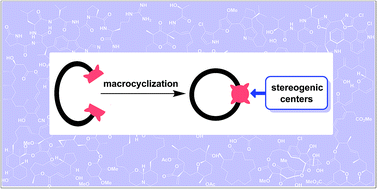Stereoconfining macrocyclizations in the total synthesis of natural products†
Abstract
Covering: selected examples in the past three decades (up to 2018)
The challenging structures and often potent biological activities of naturally occurring macrocycles have attracted much attention among the synthetic community. In a typical retrosynthetic disconnection, commonly used macrocyclization tactics, including macrolactonization, macrolactamization, ring-closing metathesis, olefination, and metal-mediated cross-coupling reactions, are invariably based on linear substrates in which all of the stereogenic centers have already been set forth. Macrocyclizations with the simultaneous installation of the requisite stereogenic centers can be advantageous with respect to a broader substrate spectrum as well as a usually higher overall synthetic efficiency. However, achieving predictably high levels of stereocontrol remains a formidable challenge. In this review, we discuss representative examples of those “nonclassic” macrocyclization strategies in the context of natural product total synthesis. Different types of macrocycle-forming methods are summarized, with a particular focus on the sense of diastereoinduction imparted through the transition-state macrocyclic ring architecture (≥12-membered) or the catalyst.



 Please wait while we load your content...
Please wait while we load your content...